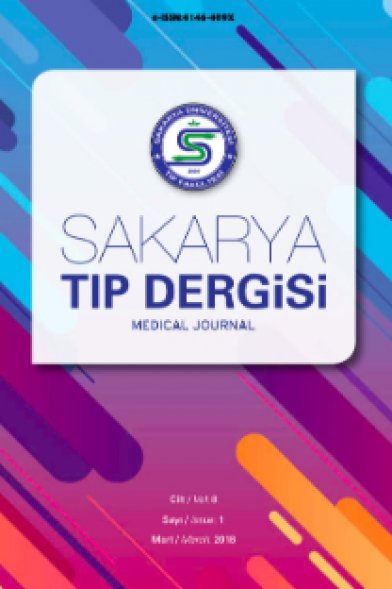Hemoptizi Yakınması ile Başvuran Hastalarda Etyolojik Değerlendirme
Etiological Evaluation in Patients Presenting with Hemoptysis
___
- 1. .Jeudy J, Khan AR, Mohammed TL, et al: ACR. Appropriateness Criteria hemoptysis. J Th orac Imaging 2010; 25:67-69.
- 2. Özlu T. Massif hemoptizi. İçinde: Ekim N, Turktaş H, editör. Goğüs hastalıkları acilleri. 1. Baskı. Ankara: Bilimsel Tıp Yayınevi; 2000. s.241-246.
- 3. Hirsberg B, Biran I, Glazer M, et al: Hemoptysis: etiology, evaluation, and outcome in a tertiary referral hospital.Chest 1997; 112(2):440-444.
- 4. Corey R, Hla KM. Major and massive hemoptysis: reassessment of conservative management. Am J Med Sci 1987; 294(5):301-309.
- 5. Patel SR. Stoller JK: Th e role of bronchoscopy in hemoptysis. İn: Wang K, Mehta AC (eds). Flexible Bronchoscopy. Cambridge: Blackwell Science, 1995: p.298-321.
- 6. Lordan JL, Gascoigne A, Corris PA. Th e pulmonary physician in criticalcare. Illustrative case 7: Assessment and management of massive hemoptysis. Th orax 2003; 58(9):814-819.
- 7. Weinberger SE, Braunwald E. Cough and hemoptysis. In: Braunwald E, Fauci AS, Kasper DL, Hauser SL, Longo DL, Jameson JL (eds). Harrison’s Principles of Internal Medicine, 15 th ed. New York: McGraw-Hill. 2001: p.203-206.
- 8. Reisz G, Stevens D, Boutwell C, et al: Th e causes of hemoptysis revisited. A review of the etiologies of hemoptysis between 1986 and 1995. MoMed 1997; 94:633-637.
- 9. Santiago S, Tobias J, Williams AJ. A reappraisal of the causes of hemoptysis. Arch Intern Med 1991; 151(12):2449-2451.
- 10. Herth F, Ernst A, Becker HD. Long-term outcome and lung cancer incidence in patients with hemoptysis of unknown origin. Chest 2001; 120(5):1592-1594.
- 11. Lee BR, Yu JY, Ban HJ, et al. Analysis of patients with hemoptysis in a tertiary referral hospital. Tuberc Respir Dis (Seoul) 2012; 73(2):107-114.
- 12. Doğan ÖT, Berk S, Engin A, Akkurt İ. Hemoptizide etiyolojk faktörler. Cumhuriyet Tıp Dergisi 2010; 32:48-53.
- 13. Özgül MA, Turna A, Yıldız P, Ertan E, Kahraman S, Yılmaz V. Risk factors and recurrence patterns in 203 patients with hemoptysis Tüberküloz ve Toraks Dergisi 2006; 54(3): 243- 248.
- 14. McGuinness G, Beacher JR, Harkin TJ, Garay SM, Rom WN, Naidich DP. Hemoptysis: prospective high-resolution CT/bronchoscopic correlation. Chest 1994; 105(4):1155-1162.
- 15. Set PA, Flower CD, Smith IE, Chan AP, Twentyman OP, Shneerson JM. Hemoptysis: comparative study of the role of CT and fiberoptic bronchoscopy. Radiology 1993; 189(3):677-680.
- 16. Yoon W, Kim JK, Kim YH, Chung TW, Kang HK. Bronchial and nonbronchial systemic artery embolization for life threatening hemoptysis: a comprehensive review. Radiographics 2002; 22(6):1395-1409.
- 17. İntepe Y.S, Aydın Y. Hemoptizi: Tanısal yöntemlerin karşılaştırılması ve Akciğer Kanseri için risk faktörlerinin belirlenmesi. Bozok Tıp Dergisi 2016; 6(2):38-47.
- 18. Garzon AA, Gourin A. Surgical management of massive hemoptysis. A ten-year experience. Ann Surg. 1978; 187(3):267-271.
- 19. Conlan AA, Hurwitz SS, Krige L, Nicolaou N, Pool R. Massive hemoptysis. Review of 123 cases. J Th orac Cardiovasc Surg. 1983; 85(1):120-124.
- 20. Knott-Craig CJ, Oostruizen JG, Rossouw G, Joubert JR, Barnard PM. Management and prognosis of massive hemoptysis. Recent experience with 120 patients. J Th orac Cardiovasc Surg. 1993; 105(3):394-397.
- 21. Lee TW, Wan S, Choy DK, Chan M, Arifi A, Yim AP. Management of massive hemoptysis: a single institution experience. Ann Th orac Cardiovasc Surg. 2000; 6(4):232-235.
- 22. Jougon J, Ballester M, Delcambre F, et al: Massive hemoptysis: what place for medical and surgical treatment. Eur J Cardiothorac Surg. 2002; 22(3):345-351.
- 23. Ünsal E, Köksal D, Çimen F, Hoca NT, Şipit T. Analysis of patients with hemoptysis in a reference hospital for chest diseases. Tüberküloz ve Toraks Dergisi 2006; 54(1):34-42.
- 24. Çelik P, Gönlügür U, Akın M, Orman A. “Hemoptizili Olgularımızın Analizi”.Heybeliada Tıp Bülteni Ocak 1997; 3:45-48.
- 25. Nawal SK, Heda MR. Hemoptysis: A prospective analysis of 110 cases. Asian J Biomed Pharm Sci 2013; 3:1-3.
- 26. Şenyiğit A, Bayram H, Asan E, Bukte Y, Topçu F. “Akciğer Radyografisi Normal Saptanan Hemoptizili Olgularda Fiberoptik Bronkoskopi ve Yüksek Rezolüsyonlu Bilgisayarlı Tomografinin Tanıdaki Değeri”. Solunum Hastalıkları 2001; 12:123-128.
- 27. Tsoumakidou M, Chrysofakis G, Tsiligianni I, Maltezakis G, Siafakas NM, Tzanakis N. Prospective Analysis of 184 Hemoptysis Cases – Diagnostic Impact of Chest X-Ray, Computed Tomography, Bronchoscophy. Respiration 2006; 73(6):808-814. 28. Seki N, Shiozaki G, Ota M. Risk Factors for a Second Episode of Hemoptysis. Clinical Medicine: Circulatory Respiratory and Pulmonary Medicine 2009; 3:1-7
- Yayın Aralığı: 4
- Başlangıç: 2011
- Yayıncı: Sakarya Üniversitesi
Epilepsi Cerrahisi Sonrası Geç Başlangıçlı Kleptomani: Bir Olgu Sunumu
Pınar SİVRİKAYA, Çiçek HOCAOĞLU
Sermin TOK UMAY, Furkan Ertürk URFALI, Mehmet KORKMAZ
Hatice HALİS, M. Görkem AKSU, Eda YİRMİBEŞOĞLU ERKAL, E. Binnaz SARPER
Fulya AKTAN KİBAR, Gökhan OTURAK, Hasan Çetin EKERBİÇER, Ufuk BERBEROĞLU
Yaşar KESKİN, Kevser GÜMÜŞSU, Teoman AYDIN, Sevde ÖZER POŞUL, Esra BAŞAR GÜRSOY
Cevriye MÜLKOĞLU, Fikriye Figen AYHAN
Hemoptizi Yakınması ile Başvuran Hastalarda Etyolojik Değerlendirme
Mehmet Ali Aslaner, Mustafa Çolak
Eozinofilik Gastroenterit: Disfaji ile Başvuran Bir Olgu
Akut Kolesistit ile Başvuran Atipik Bruselloz Olgusu
Sevil ALKAN ÇEVİKER, Habibe Tülin ELMASLAR MERT, Mehmet Ali GEDİK
